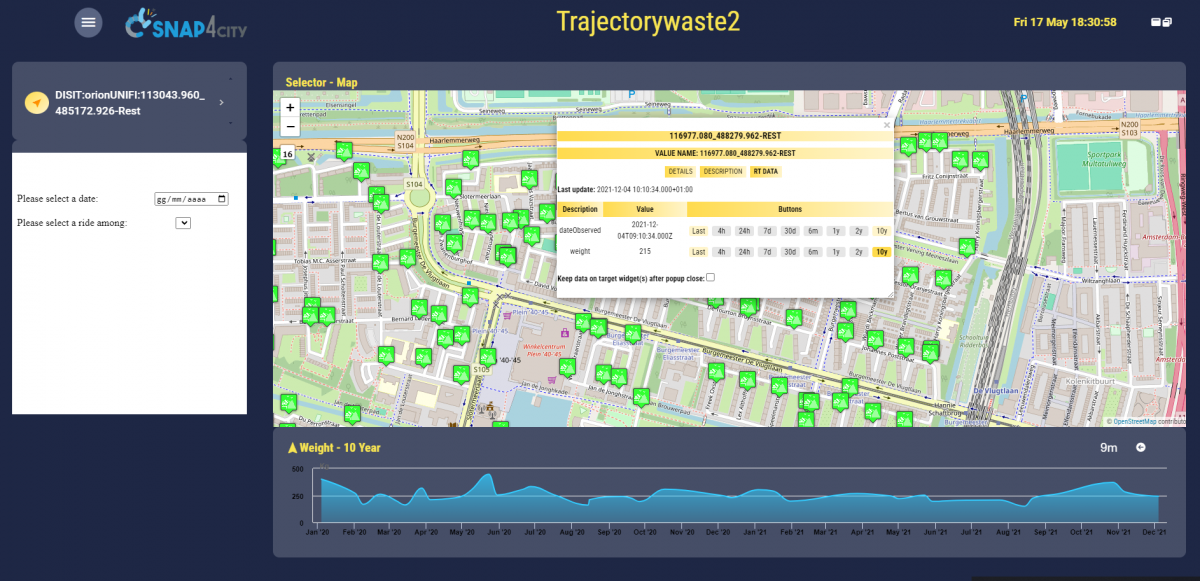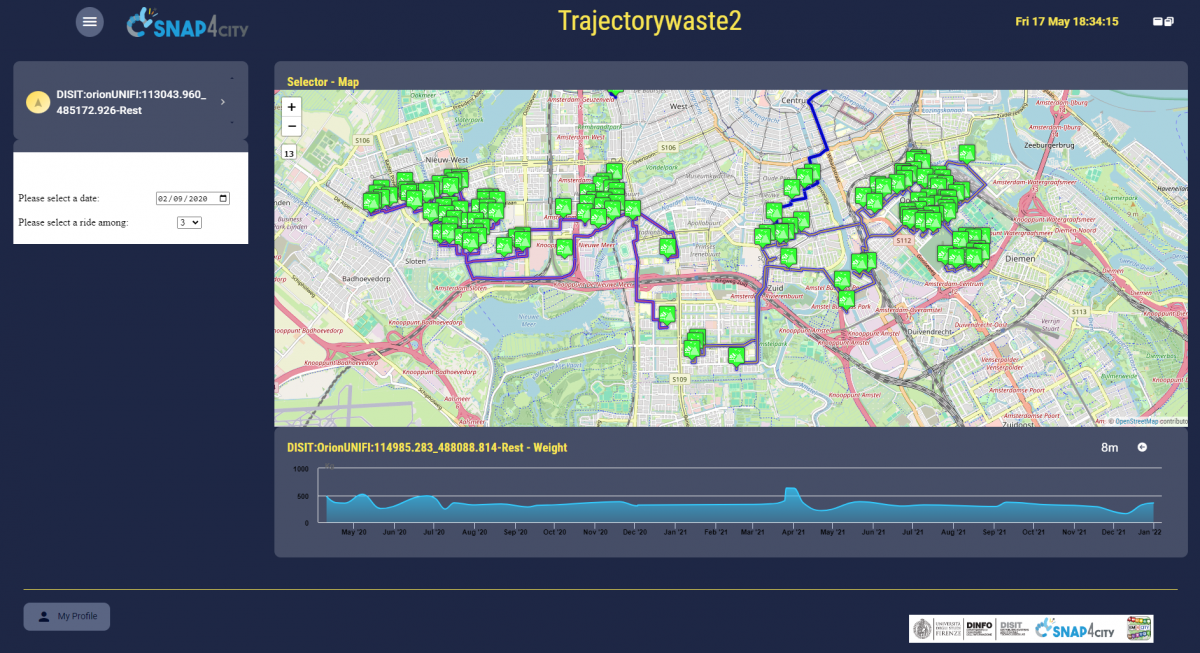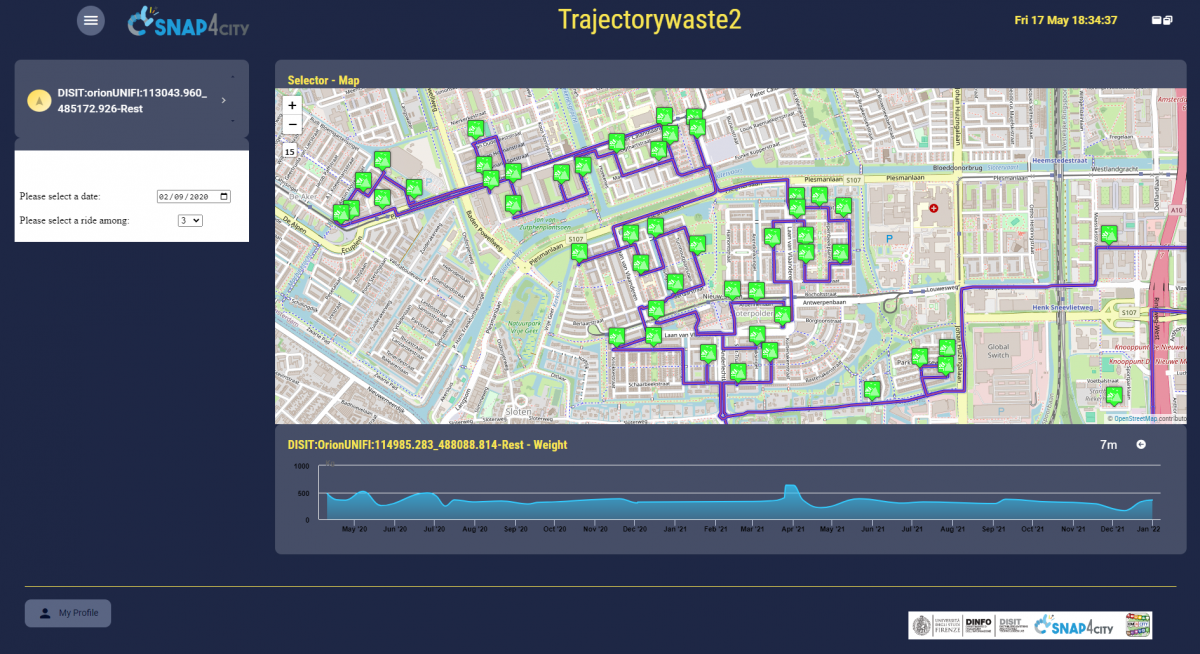Snap4City Smart waste management system aims to (i) collect and monitor data from bins (status, temperature, and a number of alarms, etc.) and trucks (weights collected, when possible) according to differentiated waste collection; (ii) optimize waste collection and management in urban environments using technologies such as IoT sensors, GPS, and data analytics. While these systems offer significant benefits, including operational efficiencies, cost savings, and environmental benefits, they also face several challenges, like, among the others: initial investment, technology adoption and integration, maintenance, scalability and flexibility, environmental impact, interoperability. Addressing these challenges requires careful planning, investment, and collaboration among stakeholders, including city planners, technology providers, waste management companies, and the community.
Snap4City can help cities implement cost-effective smart waste management solutions by providing a flexible, scalable and modular platform. This allows cities to start small and scale up as needed, potentially reducing initial investments. The platform is designed to be interoperable, allowing for seamless integration with existing waste management systems and other city services, and a range of different waste bin sensors and lockers. This approach eases the adoption of smart technologies and enhances their effectiveness through comprehensive data analysis.
Snap4City provides tools for the continuous monitoring and maintenance of IoT devices and sensors and the flexible and scalable architecture allow cities to expand their smart waste management systems as needed. Snap4City supports the addition of new sensors, devices, and functionalities, making it easier to adapt to changing needs, also reaching the policies as Pay As You Throw, PAYT, provided that the bins are controlled with fobs, NFC, rfid, etc.
Snap4City has implemented a number of use cases to demonstrate how can support cities in overcoming the challenges associated with smart waste management, by facilitating the integration of IoT technologies, enhancing data security, and promoting citizen engagement, to help cities optimize their waste management practices and move towards a more sustainable future. The engagement is especially addressed to the city commercial operators which have special need in providing a large amount of waste (such as restaurants, fast food, bars, and shopping centers).
Snap4City is capable to identify the bins that risk to become true in advance (using predictive technologies based on AI, Deep Learning). On these aspects, the plan for waste collection including the rides is estimated and provided to the riders also exploiting the routing on the basis of the routing service of Snap4City. The paths for the operators can be provided to map on mobiles and also on the Snap4City mobile Apps of the series "in a Snap". On the basis of the plan, and the effective waste collection, reports and dashboards are provided including statistic and forecast. The actual trends is daily monitored including the alarms of eventual critical conditions notified from the citizens, and/or detected by sensors such as: fire, up-side-down, hurts, too filled, run out of battery, errors, etc. (some of these events can be enabled on the basis of the sensors positioned to the bin)
In the following scenario, a Smart Waste use case has been explored. The map view shows the different kinds of smart waste bins (generic, plastic, paper, glass, metal, organic) with their status (Full, Hal-full, Empty, and/or proportionally depicted on the graphic representation). Custom user interface and theme can be defined for each municipality as usual on Snap4City.

A table view allows to go more in deep in the status of each single bin and to see the following details:
- waste kind, sensor kind, etc.
- Address, position,
- Percentage of fullness (the cell is coloured according to defined thresholds, analogical display);
- Temperature (the cell is coloured according to defined thresholds);
- Group Id of the bin;
- Capacity of the bin;
- Status;
- Date of the last measurement.
- eventually icon with different Color on the basis of waste kind, or waste conditions, or waste fulness, etc.

It is possible to define thresholds for temperature and fullness.


In the following figures the position of the waste bin and the possibility to make queries to retrieve their data is presented. In the successive figure, some different paths planned for the next day are shown. For each waste bin the supposed amount of waste is also accessible, which will be compared with the actual value loaded. The possibility of weighting the waste may depend on the capability of the truck (with some sensor on the arm) or directly on the sensor of the bin for those which are capable to measure the volume of collected waste. To transform this value in effective weight a conversion has to be performed on statistical basis, and can be easily performed in few days of working.
The Snap4City solution can be endowed by an optimizer which takes into account: the position of the depot; the capabilities of the trucks and their number; the capability of the bins, instrumentation, usage / kind, position, etc.; the possibility of providing access to the bins via fobs; the actual routing time on the city map; etc. The minimal optimized is based on Genetic Algorithms, which on the basis of the above mentioned parameters plus a few of other, may produce the collecting solution for the successive waste collection trips (typically the they after).
All the results and parameters are view/set from the views/dashboards of Snap4City interface of the Smart Waste Manger which can be provided with different customized user interface and styles.


